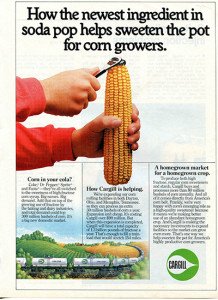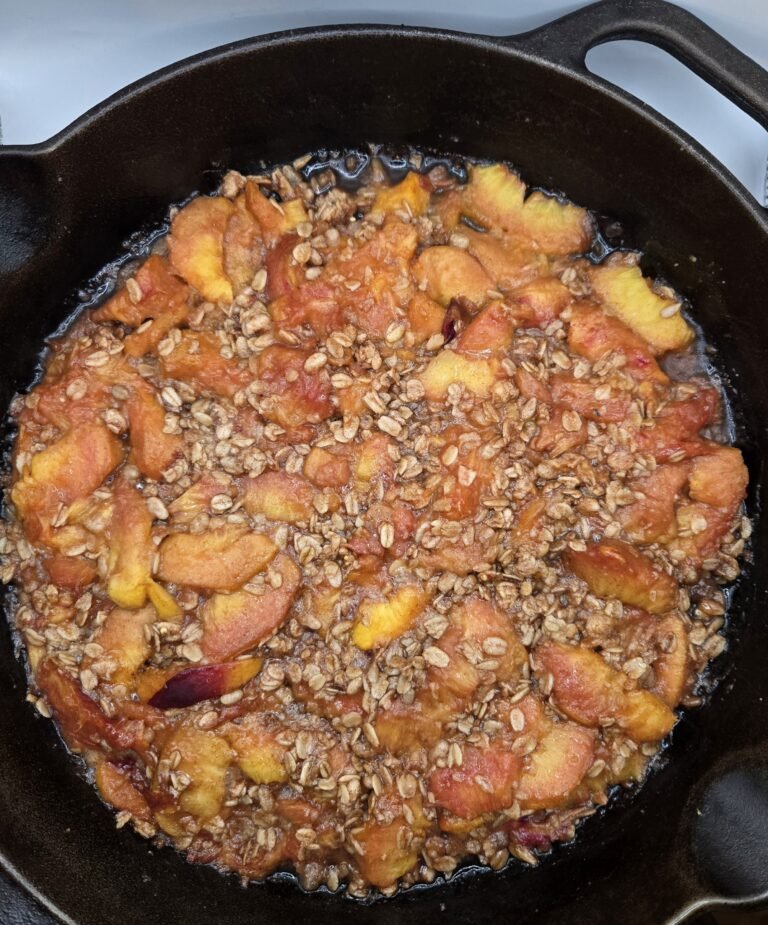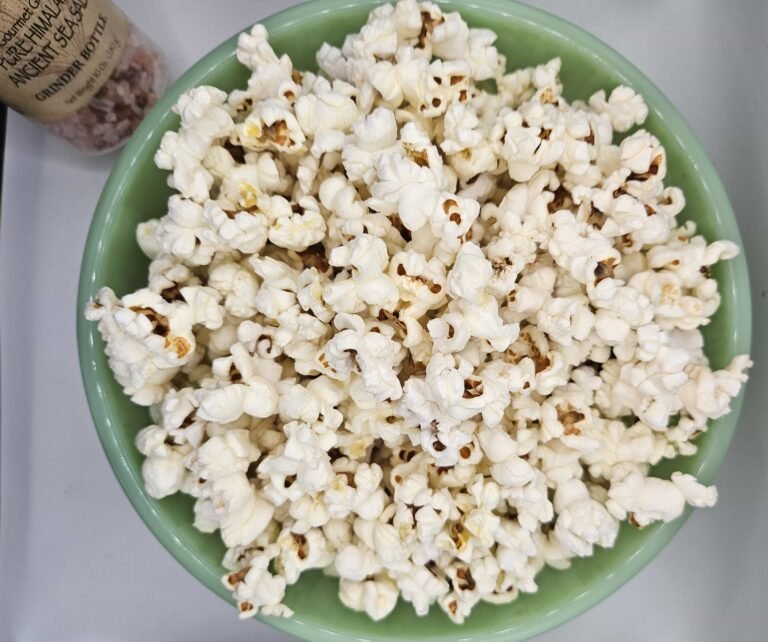Previously I mentioned how most of the 90 million acres of yellow field corn in the United States is genetically modified and fed to animals – including cows and salmon who naturally do not eat corn. What isn’t fed to animals is processed into hundreds of food additives besides high fructose corn syrup (HFCS), and hundreds of other household products.
One time I saw a magazine ad in Cooking Light promoting high fructose corn syrup. The ad depicts a woman telling her friend that her hair dresser told her to avoid HFCS; and her friend replies, “Your hair dresser is a doctor?” I hope people can recognize fake food (and corporate propaganda) without a doctor. Besides fructose being cheap (uses up a lot of excess corn), it increases the shelf life of processed foods. The hepatic (liver) metabolism of fructose is really interesting. Contrary to glucose, fructose is metabolized mainly in the liver in a rapid process independent of insulin. Glucose tends to be transported to the liver but could be metabolized anywhere in the body.[1] How that affects us in the end besides putting an overload on your liver, is still being researched and debated. When something definite from a solid research source is published, I’ll report back.
Besides what I’ve mentioned previously that the more fructose you eat, the hungrier you feel, large amounts of fructose seem to stimulate the liver’s ability to make fat. And if you eat too much fructose, the liver becomes even better at making fat. Furthermore, it appears that too much fructose and glucose in the diet may disable the body’s ability to regulate testosterone and estrogen levels. That disability is associated with an increased risk of acne, infertility, ovarian cysts, cardiovascular disease, and uterine cancer in overweight women.[2] Back to HFCS’s beginning – corn. I really started considering our corn overload when these two guys in the movie King Corn have their hair analyzed and find out it’s over 50 percent corn. The premise of the movie is these two friends move west together and start growing and learning everything about corn. The professor who tests their hair, Stephen Macko, says he’s tested hair up to 85 percent corn. We don’t really pay attention to how much corn-derived product we eat – just about everything. Someone allergic to corn has a heck of a time because out of hundreds of corn-derived additives, only a few of them have the word “corn” in them.
Besides all of the factory animals being fed corn, including fish, you end up eating corn in most processed foods. Michael Pollan[3] explains how: “The eggs are made of corn. The milk and cheese and yogurt, which once came from dairy cows that grazed on grass, now typically come from Holsteins that spend their working lives indoors tethered to machines, eating corn. To wash down your chicken nuggets with any soft drink in the supermarket is to have some corn with your corn. Grab a beer for your beverage and you’d still be drinking corn, in the form of alcohol fermented from glucose refined from corn. Read the ingredients on the label of any processed food and corn is what you will find. For modified or unmodified starch, for glucose syrup and maltodextrin, for crystalline fructose and ascorbic acid, for lecithin and dextrose, lactic acid and lysine, for maltose and HFCS, for MSG and polyols, for the caramel color and xanthan gum, read: corn. This goes for non-food items as well – everything from the toothpaste and cosmetics to the disposable diapers, trash bags, cleansers, charcoal briquettes, matches, and batteries, right down to the shine on the cover of the magazine by the checkout: corn.
Despite all of these uses industries have found for corn, you’ll see in King Corn that corn is still stockpiled and going unused. Last fall was a record U.S. corn harvest. Lawmakers passed a five-year farm law in February 2014 and hailed its projected savings in subsidies of $14 billion over a decade.[4] The forecast was based on farmers getting paid more for their crops. Instead, prices have fallen due to increased production, triggering subsidies the law aimed to reduce. Yet, in the United States, farming families are more than twice as likely to live in poverty.[5] They have less education and lower rates of medical protection, along with higher rates of infant mortality, alcoholism, child abuse, spousal abuse, and mental stress. So, as Michael Pollan says, the plague of cheap corn goes on, impoverishing farmers (both here and in the countries to which we export it), degrading the land, polluting the water, and bleeding the federal treasury.
Meanwhile major corporations like Cargill and Archer Daniels Midland (ADM) are the beneficiaries of the subsidies. Together they buy somewhere near a third of all the corn grown in America. They provide the pesticide and fertilizer to the farmers; operate most of American’s grain elevators; broker and ship most of the exports; perform the wet and dry milling; feed the livestock and then slaughter the corn-fattened animals; distill the ethanol; and manufacture the high-fructose corn syrup and the other products derived from field corn. Cargill is the largest privately held corporation in the world as it has been for all but two years since Forbes started publishing rankings in 1985.[6]
There are some great, straightforward quotes about field corn from folks interviewed in King Corn. One is from Ricardo Salvador, now the director of the Food & Environment Program at UCS, “Less expensive food is the worst for you. We aren’t growing corn, we’re growing crap.” Another good one is from Ken Cook, Environmental Working Group, “We subsidize happy meals but not the healthy ones.” Our planet and the people on it will be best off if we all eat real food and get our fructose from eating fruit instead of processed foods (corn), and our corn from good old-fashioned sweet corn.
[1] “Health Implications of Fructose Consumption: A Review of Recent Data,” S Rizkalla, Nutrition and Metabolism, 2010:7.
[2] Food Matters: A Guide to Conscious Eating, Mark Bittman, Simon & Schuster, 2009.
[3] Michael Pollan, the Omnivore’s Dilemma: A Natural History of Four Meals, Penguin Press, 2006.
[4] “Farmers May Reap Subsidy Boom on Record Crops,” by Alan Bjerga, Bloomberg, Oct. 20, 2014.
[5] #156 Jon M. Bailey and Kim Preston, Swept Away: Chronic Hardship and Fresh Promise on the Rural Great Plains (Walthill, Nebraska: Center for Rural Affairs, 2003), pp. 8-14.
[6] “America’s Largest Private Companies 2014,” by Andrea Murphy, Forbes, Nov. 2014.





